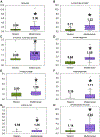Consumption of Mediterranean versus Western Diet Leads to Distinct Mammary Gland Microbiome Populations
- PMID: 30282037
- PMCID: PMC6338220
- DOI: 10.1016/j.celrep.2018.08.078
Consumption of Mediterranean versus Western Diet Leads to Distinct Mammary Gland Microbiome Populations
Abstract
Recent identification of a mammary gland-specific microbiome led to studies investigating bacteria populations in breast cancer. Malignant breast tumors have lower Lactobacillus abundance compared with benign lesions, implicating Lactobacillus as a negative regulator of breast cancer. Diet is a main determinant of gut microbial diversity. Whether diet affects breast microbiome populations is unknown. In a non-human primate model, we found that consumption of a Western or Mediterranean diet modulated mammary gland microbiota and metabolite profiles. Mediterranean diet consumption led to increased mammary gland Lactobacillus abundance compared with Western diet-fed monkeys. Moreover, mammary glands from Mediterranean diet-fed monkeys had higher levels of bile acid metabolites and increased bacterial-processed bioactive compounds. These data suggest that diet directly influences microbiome populations outside the intestinal tract in distal sites such as the mammary gland. Our study demonstrates that diet affects the mammary gland microbiome, establishing an alternative mechanistic pathway for breast cancer prevention.
Keywords: bile acid; breast; diet; hippurate; mammary gland; microbiome; oxidative stress.
Copyright © 2018 The Authors. Published by Elsevier Inc. All rights reserved.
Conflict of interest statement
DECLARATION OF INTERESTS
The authors declare no competing financial interests.
Figures






References
-
- Aragón F, Carino S, Perdigón G, and de Moreno de LeBlanc A (2014). The administration of milk fermented by the probiotic Lactobacillus casei CRL 431 exerts an immunomodulatory effect against a breast tumour in a mouse model. Immunobiology 219, 457–464. - PubMed
-
- U.S. Department of Agriculture, Agricultural Research Service (2014). Energy intakes: percentages of energy from protein, carbohydrate, fat, and alcohol, by gender and age What We Eat in America, National Health and Nutrition Examination Survey 2011–2012 (Washington: U.S. Department of Agriculture; ).
-
- Be´ dard A, Riverin M, Dodin S, Corneau L, and Lemieux S (2012). Sex differences in the impact of the Mediterranean diet on cardiovascular risk profile. Br. J. Nutr 108, 1428–1434. - PubMed
-
- Brandtzaeg P, Johansen FE, Baekkevold ES, Carlsen HS, and Farstad IN (2004). The traffic of mucosal lymphocytes to extraintestinal sites.J. Pediatr. Gastroenterol. Nutr 39 (Suppl 3), S725–S726. - PubMed
Publication types
MeSH terms
Grants and funding
LinkOut - more resources
Full Text Sources

